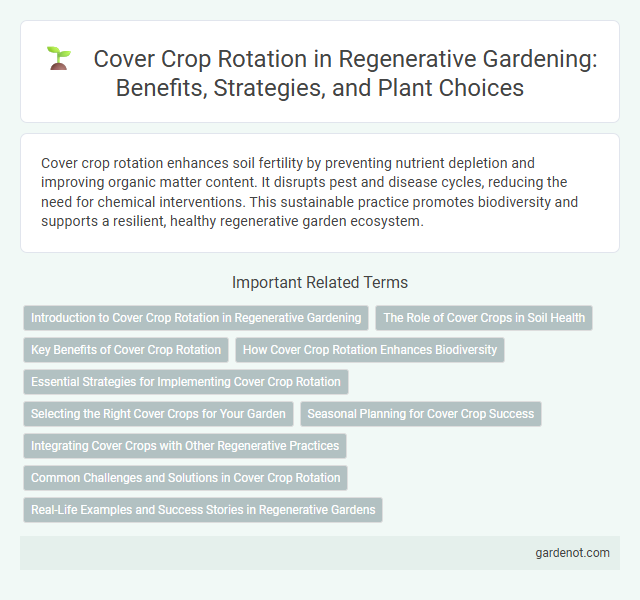Cover crop rotation enhances soil fertility by preventing nutrient depletion and improving organic matter content. It disrupts pest and disease cycles, reducing the need for chemical interventions. This sustainable practice promotes biodiversity and supports a resilient, healthy regenerative garden ecosystem.
Introduction to Cover Crop Rotation in Regenerative Gardening
Cover crop rotation in regenerative gardening enhances soil fertility, controls pests, and reduces erosion by alternating plant species that provide diverse nutrients and organic matter. Leguminous cover crops like clover or vetch fix atmospheric nitrogen, boosting soil nutrient levels naturally, while grasses like rye improve soil structure and suppress weeds. Rotating cover crops optimizes soil health, supports beneficial microbial activity, and promotes resilient ecosystems for sustainable agriculture.
The Role of Cover Crops in Soil Health
Cover crops play a crucial role in improving soil health by enhancing soil structure, increasing organic matter, and preventing erosion. Their root systems help maintain soil porosity and promote microbial activity, essential for nutrient cycling and carbon sequestration. Implementing cover crop rotation disrupts pest cycles and replenishes soil nutrients, fostering resilient and regenerative garden ecosystems.
Key Benefits of Cover Crop Rotation
Cover crop rotation enhances soil health by improving nutrient cycling and increasing organic matter content, which boosts crop productivity. It effectively suppresses weeds and reduces pest and disease pressure through diverse plant species interfering with pest life cycles. Rotating cover crops also minimizes soil erosion and improves water retention, promoting long-term farm sustainability.
How Cover Crop Rotation Enhances Biodiversity
Cover crop rotation increases soil biodiversity by providing varying root structures and organic matter that support diverse microbial communities and beneficial insects. Different cover crops replenish essential nutrients, break pest and disease cycles, and improve soil health, promoting a balanced ecosystem. This diversified plant sequence fosters habitat variety, encouraging pollinators and natural predators that contribute to a resilient regenerative garden.
Essential Strategies for Implementing Cover Crop Rotation
Implementing cover crop rotation enhances soil fertility, reduces pest pressure, and improves water retention by alternating species with complementary traits such as legumes for nitrogen fixation and grasses for biomass. Strategic timing of planting and termination maximizes benefits, ensuring cover crops do not compete with main crops for resources. Integrating diverse cover crops like clover, rye, and vetch sustains microbial diversity and interrupts pest and disease cycles crucial for regenerative garden health.
Selecting the Right Cover Crops for Your Garden
Selecting the right cover crops for your garden involves considering soil type, climate, and specific nutrient needs to enhance soil health and suppress weeds. Leguminous cover crops like clover and vetch fix nitrogen, while grasses such as rye and oats improve soil structure and prevent erosion. Rotating these crops seasonally maintains soil fertility, promotes biodiversity, and supports regenerative gardening practices effectively.
Seasonal Planning for Cover Crop Success
Seasonal planning for cover crop rotation enhances soil health, boosts nutrient cycling, and suppresses weeds by selecting species that thrive in specific climate windows. Implementing winter rye or hairy vetch in cooler months improves nitrogen fixation and organic matter content, while planting buckwheat or clover during warmer seasons promotes rapid biomass growth and soil erosion control. Integrating diverse cover crops sequentially optimizes soil structure and fertility, ensuring regenerative garden success year-round.
Integrating Cover Crops with Other Regenerative Practices
Integrating cover crops with other regenerative practices enhances soil health by increasing organic matter, improving nutrient cycling, and reducing erosion. Strategic cover crop rotation supports biodiversity, boosts microbial activity, and fosters resilient soil ecosystems that complement practices like no-till farming and compost application. Combining cover crops with mulching and crop diversification maximizes carbon sequestration and optimizes water retention for sustainable garden productivity.
Common Challenges and Solutions in Cover Crop Rotation
Cover crop rotation often faces challenges such as nutrient imbalances, pest infestations, and soil structure degradation. Implementing diverse species mixtures and adjusting planting schedules can enhance soil fertility and disrupt pest life cycles. Monitoring soil health indicators and integrating organic amendments improve resilience and long-term productivity in regenerative gardens.
Real-Life Examples and Success Stories in Regenerative Gardens
Cover crop rotation in regenerative gardens significantly improves soil health by enhancing nutrient cycling and preventing erosion, as demonstrated by Gabe Brown's farm in North Dakota, where diverse cover crops increased soil organic matter by 40%. The Rodale Institute's long-term trials reveal that alternating legumes, grasses, and brassicas reduces pest pressure and boosts yields without synthetic inputs. These success stories highlight the critical role of strategic cover crop rotation in building resilient, productive ecosystems within regenerative gardening.
Cover crop rotation Infographic

 gardenot.com
gardenot.com